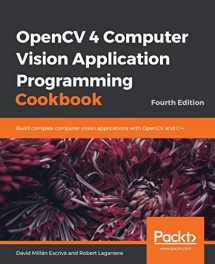
OpenCV 4 Computer Vision Application Programming Cookbook
Book details
Summary
Description
Discover interesting recipes to help you understand the concepts of object detection, image processing, and facial detection
Key Features- Explore the latest features and APIs in OpenCV 4 and build computer vision algorithms
- Develop effective, robust, and fail-safe vision for your applications
- Build computer vision algorithms with machine learning capabilities
OpenCV is an image and video processing library used for all types of image and video analysis. Throughout the book, you'll work through recipes that implement a variety of tasks, such as facial recognition and detection. With 70 self-contained tutorials, this book examines common pain points and best practices for computer vision (CV) developers. Each recipe addresses a specific problem and offers a proven, best-practice solution with insights into how it works, so that you can copy the code and configuration files and modify them to suit your needs.
This book begins by setting up OpenCV, and explains how to manipulate pixels. You'll understand how you can process images with classes and count pixels with histograms. You'll also learn detecting, describing, and matching interest points. As you advance through the chapters, you'll get to grips with estimating projective relations in images, reconstructing 3D scenes, processing video sequences, and tracking visual motion. In the final chapters, you'll cover deep learning concepts such as face and object detection.
By the end of the book, you'll be able to confidently implement a range to computer vision algorithms to meet the technical requirements of your complex CV projects
What you will learn- Install and create a program using the OpenCV library
- Segment images into homogenous regions and extract meaningful objects
- Apply image filters to enhance image content
- Exploit image geometry to relay different views of a pictured scene
- Calibrate the camera from different image observations
- Detect people and objects in images using machine learning techniques
- Reconstruct a 3D scene from images
- Explore face detection using deep learning
If you're a CV developer or professional who already uses or would like to use OpenCV for building computer vision software, this book is for you. You'll also find this book useful if you're a C++ programmer looking to extend your computer vision skillset by learning OpenCV.
Table of Contents- Introduction to OpenCV
- Manipulating the pixels
- Processing Images with Classes
- Counting the Pixels with Histograms
- Transforming images with morphological operations
- Filtering the images
- Extracting Lines, Contours, and Components
- Detecting interest points
- Describing and Matching interest Points
- Estimating projective relations in images
- Reconstructing 3D scenes
- Processing video sequences
- Tracking visual motion
- Learning from Examples
- OpenCV Advanced features


We would LOVE it if you could help us and other readers by reviewing the book
Book review



